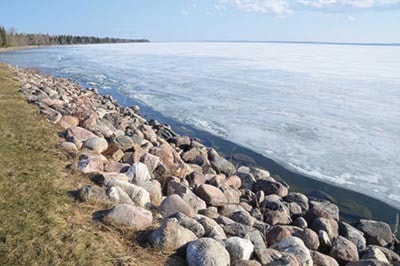A non-profit group active in the Pigeon Lake area says local governments and other decision-makers aren’t considering all alternatives when it comes to wastewater systems.
The Pigeon LakeWise group dropped by the Pipestone Flyer May 3 to discuss local government’s apparent preference for low-pressure wastewater systems for residences around Pigeon Lake.
The issue of wastewater around Pigeon Lake has been controversial for years, as the algae blooms that affect recreation in Pigeon Lake are usually blamed on nutrients getting into the lake from human waste.
Dan Neil, a resident of the Pigeon Lake area, a member of Pigeon LakeWise Society and a retired engineer who worked both in the private and public sector, partly for the Government of Alberta, said in his opinion a person does not need to be an engineer to see problems with low-pressure wastewater systems which, basically, rely on wastewater flow to function as intended.
Neil said in the summer, Pigeon Lake is busy, so the low-pressure systems would likely have lots of material to keep the flow going. However, other than peak summer months, in the winter the villages around Pigeon Lake are less occupied, and the communal pipes will be prone to inadequate flow, producing hydrogen sulfide gas, pipe channel obstruction and build-up of toxic waste material, bacteria, as well as the risk of lines freezing.
“Wolf Creek had a similar problem of low flow during winter months and lines freezing,” noted Neil in a written statement. “The solution was to significantly increase the line flow by installing a freshwater well to constantly feed potable water into the line to keep it from freezing. A solution like that would probably also increase the system’s velocity in those time periods, but to me it seems like a wasteful and environmentally (unsound) thing to do.
“This is where good planning comes in. The period when a project is first conceived is where you make decisions that have the greatest impact on overall cost.”
He noted the low-pressure systems could benefit from a shut-off valve which could address the freeze-up problem when the property owner isn’t around for long periods of time, but noted utility companies have been known to charge up to $350 for staff to turn on or off such a valve.
“So, if you want peace of mind, having a shut-off valve would protect from improper flow in the communal pipes into resident systems when you are away for extended periods of time,” Neil stated. “Except for the charge for turning that valve on and off. In Yellowhead County that charge is $50 per disconnection and $50 per reconnection, which is more reasonable. But I can see that it would be expensive for an owner who would want peace of mind, if they made several trips back and forth per year.”
Neil said Cadomin developed a “winterization” booklet for their low-pressure systems and freeze-up problems. “They had low population in the winter months and the collection lines froze,” stated Neil. The solution was to add heat tape to the collection lines, at a cost of $250,000. Yellowhead County proposed a low-pressure system for Marlboro in 2013. Officials have stated as Marlboro has a steady year round population, they do not anticipate the problems that Cadomin encountered.
Neil also pointed out Surrey, B.C. only allows low-pressure systems under certain conditions. “…developers were trying to use low-pressure (systems) as a means to lower costs of installation in spite of a higher need for maintenance with considerable costs, for the municipality that maintains them even though it was possible to build gravity systems,” stated Neil.
Neil noted that low-pressure systems generally have lower costs for developers, and higher maintenance costs for property owners. Gravity systems, which Neil stated are feasible for Pigeon Lake area, are more expensive for developers, but more reasonable cost-wise for property owners down the line. Only with gravity systems can wastewater users “flush and forget”, which most lake area residents assumed is the system they’ll get.
The Pigeon LakeWise group takes the position that gravity systems are the best option, especially in Greenfield situations. Neil stated they’re reliable and have been used for a long time and should last about 60 years.
He used the example of Habitat Acres, a cluster low-pressure system of 17 dwellings capable of growing to 29. “They use a combination of STE pressure and STE gravity for homes with higher elevation,” stated Neil. “I haven’t really heard of any operational problems with this system. It has the advantage of a short retention time as the treatment system is in close proximity to the dwellings which may be the key to its success.
“You can’t allow sewage to sit in a collection pipe,” added Neil. “It needs to flow with enough velocity to clean itself.” A low pressure system design used in the context of long collection and transmission lines for communities with a high seasonal fluctuation in population carries with it considerable risk. The preference should be a gravity system or utilizing holding tanks with utilizing improved and more economical testing methods to assure compliance.
More information is available online at PigeonLakeWiseSociety.wordpress.com.
